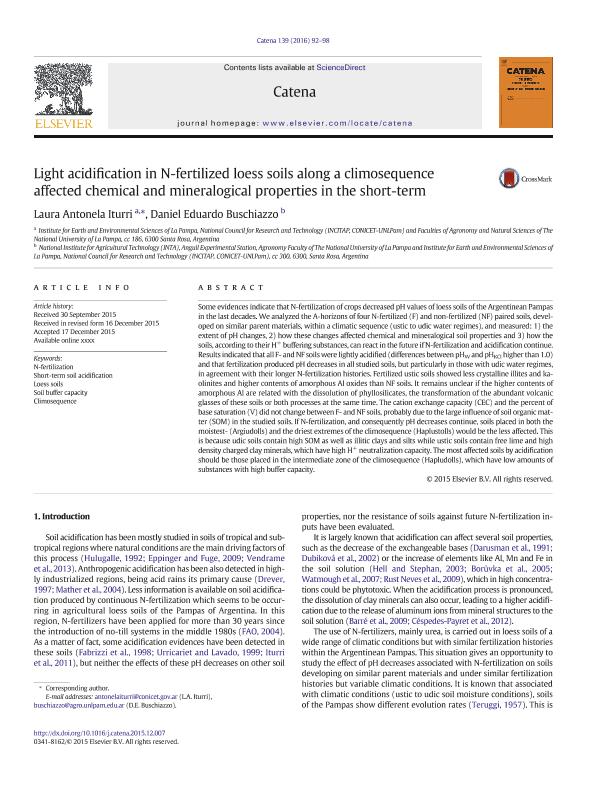Mostrar el registro sencillo del ítem
dc.contributor.author
Iturri, Laura Antonela

dc.contributor.author
Buschiazzo, Daniel Eduardo

dc.date.available
2018-05-03T19:31:19Z
dc.date.issued
2015-12
dc.identifier.citation
Iturri, Laura Antonela; Buschiazzo, Daniel Eduardo; Light acidification in N-fertilized loess soils along a climosequence affected chemical and mineralogical properties in the short-term; Elsevier Science; Catena; 139; 12-2015; 92-98
dc.identifier.issn
0341-8162
dc.identifier.uri
http://hdl.handle.net/11336/44031
dc.description.abstract
Some evidences indicate that N-fertilization of crops decreased pH values of loess soils of the Argentinean Pampas in the last decades. We analyzed the A-horizons of four N-fertilized (F) and non-fertilized (NF) paired soils, developed on similar parent materials, within a climatic sequence (ustic to udic water regimes), and measured: 1) the extent of pH changes, 2) how these changes affected some chemical and mineralogical properties and 3) how the soils, according to their H+ buffering substances, can react in the future if N-fertilization and acidification continue. Results indicated that all F- and NF soils were lightly acidified (differences between pHW and pHKCl higher than 1.0) and that fertilization produced pH decreases in all studied soils, but particularly in those with udic water regimes, in agreement with their longer N-fertilization histories. Fertilized ustic soils showed less crystalline illites and kaolinites and higher contents of amorphous Al oxides than NF soils. It remains unclear if the higher contents of amorphous Al are related with the dissolution of phyllosilicates, the transformation of the abundant volcanic glasses of these soils or both processes at the same time. The cation exchange capacity (CEC) and the percent of base saturation (V) did not change between F- and NF soils, probably due to the large influence of soil organic matter (SOM) in the studied soils. If N-fertilization and consequently pH decreases continue, soils placed in both the moistest- (Argiudolls) and the driest extremes of the climosequence (Haplustolls) would be the less affected. This is because udic soils contain high SOM as well as illitic clays and silts while ustic soils contain free lime and high density charged clay minerals, which have high H+ neutralization capacity. The most affected soils by acidification should be those placed in the intermediate zone of the climosequence (Hapludolls), which have low amounts of substances with high buffer capacity.
dc.format
application/pdf
dc.language.iso
eng
dc.publisher
Elsevier Science

dc.rights
info:eu-repo/semantics/openAccess
dc.rights.uri
https://creativecommons.org/licenses/by-nc-nd/2.5/ar/
dc.subject
N-Fertilization
dc.subject
Short-Term Soil Acidification
dc.subject
Loess Soils
dc.subject
Soil Buffer Capacity
dc.subject
Climosequence
dc.subject.classification
Otras Ciencias Agrícolas

dc.subject.classification
Otras Ciencias Agrícolas

dc.subject.classification
CIENCIAS AGRÍCOLAS

dc.title
Light acidification in N-fertilized loess soils along a climosequence affected chemical and mineralogical properties in the short-term
dc.type
info:eu-repo/semantics/article
dc.type
info:ar-repo/semantics/artículo
dc.type
info:eu-repo/semantics/publishedVersion
dc.date.updated
2018-05-03T14:11:55Z
dc.journal.volume
139
dc.journal.pagination
92-98
dc.journal.pais
Países Bajos

dc.journal.ciudad
Amsterdam
dc.description.fil
Fil: Iturri, Laura Antonela. Consejo Nacional de Investigaciones Científicas y Técnicas. Instituto de Ciencias de la Tierra y Ambientales de La Pampa. Universidad Nacional de La Pampa. Facultad de Ciencias Exactas y Naturales. Instituto de Ciencias de la Tierra y Ambientales de La Pampa; Argentina
dc.description.fil
Fil: Buschiazzo, Daniel Eduardo. Consejo Nacional de Investigaciones Científicas y Técnicas. Instituto de Ciencias de la Tierra y Ambientales de La Pampa. Universidad Nacional de La Pampa. Facultad de Ciencias Exactas y Naturales. Instituto de Ciencias de la Tierra y Ambientales de La Pampa; Argentina
dc.journal.title
Catena

dc.relation.alternativeid
info:eu-repo/semantics/altIdentifier/doi/http://dx.doi.org/10.1016/j.catena.2015.12.007
dc.relation.alternativeid
info:eu-repo/semantics/altIdentifier/url/https://www.sciencedirect.com/science/article/pii/S0341816215301740
Archivos asociados
